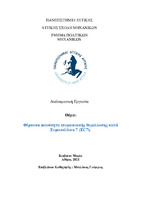| dc.contributor.advisor | Belokas, Georgios | |
| dc.contributor.author | Κωβαίου, Μαρία | |
| dc.date.accessioned | 2021-08-04T19:01:09Z | |
| dc.date.available | 2021-08-04T19:01:09Z | |
| dc.date.issued | 2021-07 | |
| dc.identifier.uri | https://polynoe.lib.uniwa.gr/xmlui/handle/11400/1065 | |
| dc.identifier.uri | http://dx.doi.org/10.26265/polynoe-916 | |
| dc.description.abstract | Οι θεμελιώσεις αποτελούν την απαρχή κάθε δομικού έργου και είναι ύψιστης σημασίας, καθώς μεταβιβάζουν τα φορτία της ανωδομής στο έδαφος. Είναι κρίσιμο το έδαφος να μην φορτιστεί πέραν της αντοχής του, δηλαδή να μην υπερβεί την
φέρουσα του ικανότητα. Λόγω της ιδιαιτερότητας των εδαφών και των συνθηκών στην εκάστοτε περιοχή μελέτης, δίνεται η δυνατότητα στα κράτη μέλη της Ευρώπης να καθορίσουν με ένα εθνικό προσάρτημα, τον τρόπο ανάλυσης και το υπολογιστικό
προσομοίωμα υπολογισμού της φέρουσας ικανότητας, με την προϋπόθεση να μην υπερβαίνει τις οριακές καταστάσεις αστοχίας. Στην παρούσα διπλωματική εργασία βασικό στόχο αποτελεί η διερεύνηση μεθοδολογιών υπολογισμού της φέρουσας
ικανότητας επιφανειακής θεμελίωσης και πως εφαρμόζονται στον Ευρωκώδικα 7 (EC7). Με την βοήθεια υπολογιστικών φύλλων Excel πραγματοποιήθηκε συγκριτική ανάλυση των τρόπων ανάλυσης, οι οποίοι παρουσιάζονται στον Ευρωκώδικα 7 (EC7),
καθώς και του υπολογιστικού μοντέλου του παραρτήματος Δ του Ευρωκώδικα 7 (EC7) (ελληνική εθνική επιλογή) με την μεθοδολογία που συστήνει το BS8004 (βρετανική εθνική επιλογή) για στραγγισμένες και αστράγγιστες συνθήκες φόρτισης. Από τις
αναλύσεις που διεξήχθησαν, συμπεραίνουμε ότι ο Ευρωκώδικας 7 (EC7) προτείνει ένα πιο συντηρητικό μοντέλο υπολογισμού της φέρουσας ικανότητας, δεδομένου ότι αγνοεί ορισμένες καταστάσεις σχεδιασμού σε αντίθεση με την μέθοδο που παρουσιάζεται στο BS8004, στην οποία έχουν προστεθεί νέοι παράγοντες. Ακόμη, η επιλογή του τρόπου ανάλυσης και κατά συνέπεια των επιμέρους συντελεστών ασφαλείας, επηρεάζει την επάρκεια έναντι φέρουσας ικανότητας. Συμπερασματικά, ο τρόπος DA2* σε αστράγγιστες συνθήκες φόρτισης είναι πάντοτε πιο συντηρητικός από τον τρόπο ανάλυσης DA1-2. Τα συμπεράσματα που αποκομίσαμε για τις
στραγγισμένες συνθήκες διαφέρουν, διότι σε αυτήν την περίπτωση παρατηρείται, ότι ο βαθμός στον οποίο ο τρόπος ανάλυσης είναι πιο συντηρητικός εξαρτάται από τον συνδυασμό της γωνίας τριβής φ, της επιφόρτισης q και της συνοχή c. | el |
| dc.format.extent | 175 | el |
| dc.language.iso | el | el |
| dc.publisher | Πανεπιστήμιο Δυτικής Αττικής | el |
| dc.rights | Αναφορά Δημιουργού - Μη Εμπορική Χρήση - Παρόμοια Διανομή 4.0 Διεθνές | * |
| dc.rights | Attribution-NonCommercial-NoDerivatives 4.0 Διεθνές | * |
| dc.rights.uri | http://creativecommons.org/licenses/by-nc-nd/4.0/ | * |
| dc.subject | Φέρουσα ικανότητα | el |
| dc.subject | Επιφανειακές θεμελιώσεις | el |
| dc.subject | Ευρωκώδικας 7 | el |
| dc.subject | BS 8004 | el |
| dc.subject | Αστράγγιστες συνθήκες φόρτισης | el |
| dc.subject | Στραγγισμένες συνθήκες φόρτισης | el |
| dc.subject | Θεμελιώσεις | el |
| dc.title | Φέρουσα ικανότητα επιφανειακής θεμελίωσης κατά Ευρωκώδικα 7 (EC7) | el |
| dc.title.alternative | Load-bearing capacity of a surface foundation according to Eurocode 7 (EC7) | el |
| dc.type | Διπλωματική εργασία | el |
| dc.contributor.committee | Συμπέθερος, Ιωάννης | |
| dc.contributor.committee | Βαλαβανίδης, Μάριος-Προκόπιος | |
| dc.contributor.faculty | Σχολή Μηχανικών | el |
| dc.contributor.department | Τμήμα Πολιτικών Μηχανικών | el |
| dc.description.abstracttranslated | The foundation is the beginning of every construction project and is of the utmost significance, as it transfers and distributes the loads of the superstructure to the ground. It is critical that the ground is not loaded beyond its’ strength, and not exceed
its’ load-bearing capacity. Due to the specificity of the soils and the circumstances in the respective study area, it is possible for the member states of the European Union to determine with a national appendix, the method of analysis and the computational
simulation of the load-bearing capacity, provided that it does not exceed the failure thresholds. The focus of this thesis is to investigate different calculating 6 methodologies for the load-bearing capacity of a surface foundation and how they are
applied in Eurocode 7 (EC7). Firstly, a comparative analysis of the methods of analysis presented in Eurocode 7 (EC7) is performed with the use of spreadsheets. The same comparative analysis is used as well between the calculation model of Annex D of the Eurocode 7 (EC7) (Greek national selection) and the methodology recommended by BS8004 (British national selection) for drained and undrained loading conditions. From the analyses carried out, we conclude that Eurocode 7 (EC7) proposes a more
conservative model for calculating the load-bearing capacity, as it doesn’t take into consideration some certain design situations. The reason for that being that new factors have been added to the method presented in BS8004 (British national selection). Furthermore, depending on the safety factors that are used in the analysis, the adequacy against the load-bearing capacity is simultaneously affected. In conclusion, the DA2 * method regarding the undrained loading conditions is always more conservative than the DA1-2 analysis method. The conclusions we have acquired for the drained conditions differ, because in this case it is observed that the extent to which the analysis method is more conservative is determined by a combination of the friction angle φ, the load q and the coherence c. | el |


